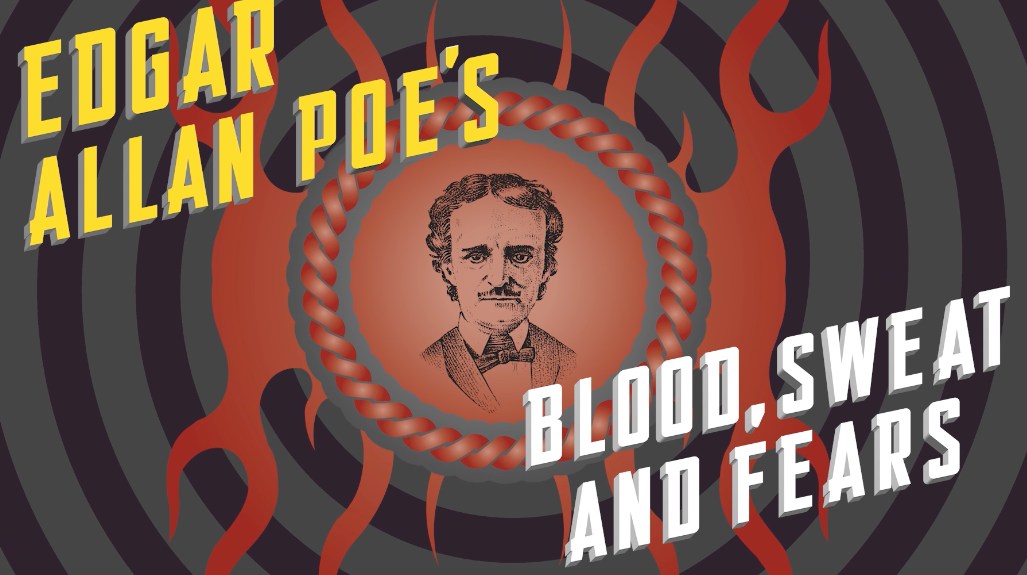Are you ready for your one-way ticket to nightmarish places? Ghastly things and ghoulish notions to put you in the mood for the season of the macabre? In their live-stage-performance debut, The National Edgar Allan Poe Theatre brings Blood, Sweat, and Fears to the FPX Events stage just east of Poe’s beloved Baltimore. Directed by Jay Brock the conceptualized work formulated by Jennifer Restak and Richard J. Hand with Alex Zavistovich, will have some of Poe’s lesser known works on display for your darkened sense of entertainment.
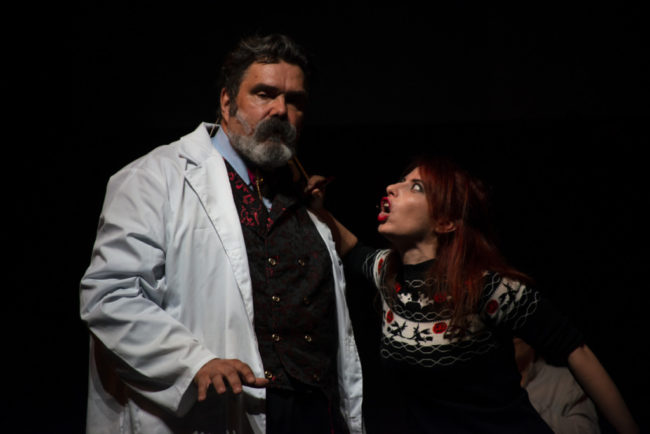
Conceptually the show, as a whole, isn’t as a tight as it could be. It’s easy to understand the framework the production was setting up— a traveling trunk show of oddities, featuring real-life human curiosities, a bit of magic, and a bristly, volatile relationship between showman and hostess. What transpires on the stage is somewhat of a disjointed attempt at the aforementioned. The largest issue regarding the show’s framework isn’t any one thing that any one performer or production component has contributed, but rather the cavernous vastness of the performance space (FPX, while an extremely exhilarating space, is a former movie theatre, with close to 400 seats and a large stage, which is an immense demand for a show that cries out in desperation for intimacy.) The magic tricks and sleight-of-hand, even the notions of this traveling trunk show as a whole, would be far better served in a contained, enclosed venue of intimacy.
Alex Zavistovich, as the show’s ringleading master, Professor Ambrose Quintillus Mallard (pronounced not like the duck) lacks the smarmy, charisma that you expect from a showman. (Chalk it up to opening night jitters, or the first time of being on stage since before the Pandemic, etc) Zavistovich’s performance leaves you yearning for that sinister charlatan, that depraved madman whose airs and charms hypnotize you into enjoying his peddled wares (think Dr. Facilier, PT Barnum, or any demon wearing human-guise that one might meet at a crossroads trying to sell you snake oil and magic.) That isn’t to say his interactions with Madame Esme Perrin (questionably Mallard’s on-again-off-again lover whilst on the road with this menagerie of human oddities), who is both the show’s opener, closer, and semi-conduit that sparks Mallard’s ‘children’ to life, aren’t entertaining…particularly once she intentionally starts mispronouncing his name, clearly in an attempt to irritate him. Some of the ‘magic’ that Zavistovich attempts doesn’t read well— between a few tells (that depending on where in the house you’re sitting may or may not be noticeable/audible) and a few bumps— but one could see what the desired effect was meant to be.
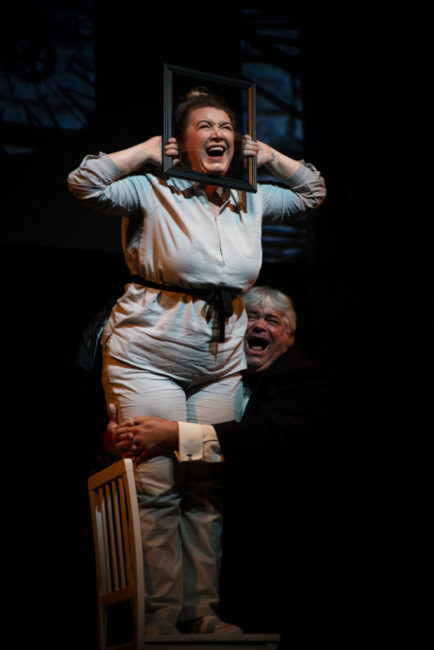
What is wondrous about this concept, wondrous strange and truly unique (if only it had cleaner execution, perhaps in a more intimate venue, with more of a macabre setting shrouding around it) is the fact that Mallard’s “children”, as they are referred in this production, essentially arrive on the stage in their psychiatric-ward-grays, completely catatonic and unresponsive. Right up until Perrin (Melanie Kurstin) puts an accessory or a piece of clothing onto them. It works like a clockwork catalyst, as if by ‘dressing them for their part’ winds them to life and with great vivacity do they spring into their respective tales. (Nowhere except for in the show’s marketing— posters and playbills— does the performance mention that these macabre tales are the work of the master himself, Edgard Allan Poe, though this seems to be but a minor, fleeting flaw in the production’s design.) This remarkable device— human storytellers who magically spring into their narratives (three works by Poe— Berenice, A Predicament, and The Tell-Tale Heart)— delivers the truly creepy and chilling sensations that one might expect from a cabaret of the macabre.
The stories themselves are presented with a flare not unlike Two-Sentence Horror Stories. Projectionist and Lighting Designer Hailey LaRoe has crafted antiquated looking ‘scene cards’, reminiscent of the old title cards that accompanied silent films. Each one is presented at the top of each ‘lesson’ (what the stories are being presented as) and then represented at the end of the tale, with a secondary note to the ‘lesson.’ It’s quite chilling. LaRoe uses a few other lighting effects, which are somewhat absorbed into the vast ether of the enormous performance space, though one could imagine how very spooky they might appear in a more quaint performance space.
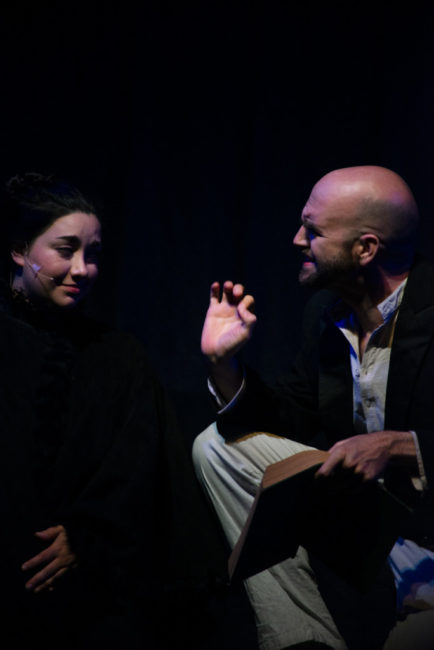
Performances across the board inside the stories…or ‘lessons’… are remarkable. The maddened Adam R. Adkins, who delivers a deranged maniac teetering on the brink of insanity, really sets your teeth on edge during Berenice. Vacillating between melancholy and maddened, Adkins is vigorously engaged in the character’s own psychosis while trying to relive the experience of monomania. Playing the titular character of this piece, Olivia Ercolano makes the character lively and sweet, despite the story’s decomposing nature. While Adkins and Ercolano’s interactions may be few, they are rather endearing and read with great authenticity. The story itself has a gruesome ending, though that black humor which features some dancing molar puppets should not be discounted as it is rather unsettling in the most quirky way possible.
While not ‘comedy’ in the traditional sense, The Predicament, has a healthy dose of gallows humor well in hand and both Anna Phillips-Brown and B. Thomas Rinaldi deliver these absurdly odd characters with great vigor. There is a prestigious sense of wealth and self-importance to Anna Phillips-Brown’s character, everything from her affected vocal cadence to the way she simply expects and demands thing from her servant (Rinaldi) reeks of affluent entitlement. When things go awry in the story, resulting in the tastefully placed gray ribbon around Phillips-Brown’s neck (shout-out to costumer Jacqui Maranville who is traumatizing all of us 80’s/90’s kids with flashbacks to “The Girl With The Green Ribbon”, but more astutely makes each of the costume accoutrements- the red cummerbund seen in Berenice or the sterile white apron seen in The Tell-Tale Heart– really pop and give an extra electricity to each of the tales), you get a real sense of how panicked the character is, plunging into her own sense of delirium.
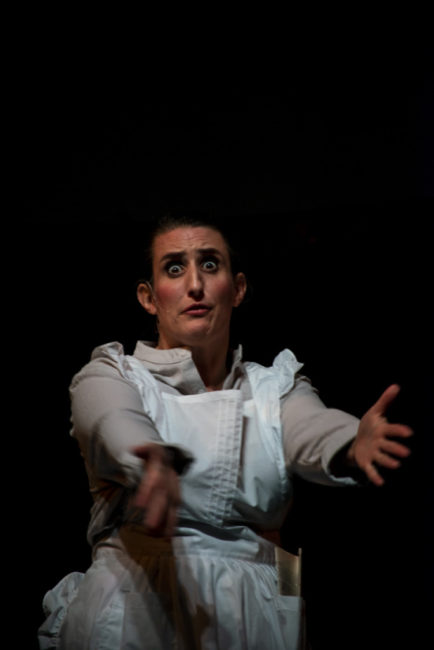
B. Thomas Rinaldi can later be seen in his finest role during the third tale of the evening, as ‘the old man’ with the ruined eye, as it were, in Poe’s iconic The Tell-Tale Heart. Playing opposite, however briefly, of Elizabeth Darby, the interactions that Rinaldi shares with Darby are a scream. Darby herself does such a meticulous job of portraying the neurotic character that you completely forget Poe wrote the narrative figure in that show as a man. (Darby refers to herself as a lady, woman, etc. throughout and it’s blindingly obviously that this ‘caretaker character could and perhaps should have always been a lady of distinct sensitivity.) Her performance as the ‘storyteller’ is a true masterpiece and makes this one of the most impressive feats of the evening.
Serving as a lyrical thread that ties…or binds…all the components and elements of the performance together, Melanie Kurstin, as Madame Esme Perrin, is truly the self-proclaimed “Nightengale of Dundalk.” With slick, vaudeville steps designed by choreographer Christen Svingos Douglass, Kurstin sashays her way into the audience’s heart, right from the beginning of the show. The evening’s entertainment opens (and closes) with a wicked rendition of “These Ghoulish Things” (which sounds largely like a plucky and spooky parody of “These Foolish Things”) which Kurstin soft-shoes her way through while crooning sweetly. The audience seems to truly delight in both Kurstin’s singing and dancing, making one wish there was even more of it throughout the performance. Catty, saucy, and ever so slightly…unhinged, Kurstin is more than just the ‘sidekick-support’ to Mallard’s menagerie of madness. She’s the central star. She just doesn’t know it yet.
Ultimately, barring some sound issues (the further away from the stage one sits the less likely one is to hear and see all of the things that are happening over the course of the 90 minutes’ entertainment), the production is intriguing and worth investigating if you enjoy some of Poe’s lesser known works…or have yet to encounter them. Not bad for a first attempt at a stage production (this being The National Edgar Allan Poe Theatre’s very first staged performance since their inception just prior to the pandemic.)
Blood, Sweat, and Fears plays October 14th through November 6th 2022 with The National Edgar Allen Poe Theatre at FPX Events— 7938 Eastern Avenue in the Dundalk neighborhood of Baltimore. Tickets are available at the door or in advance online.
To read the interview with company founder, Alex Zavistovich, click here.

